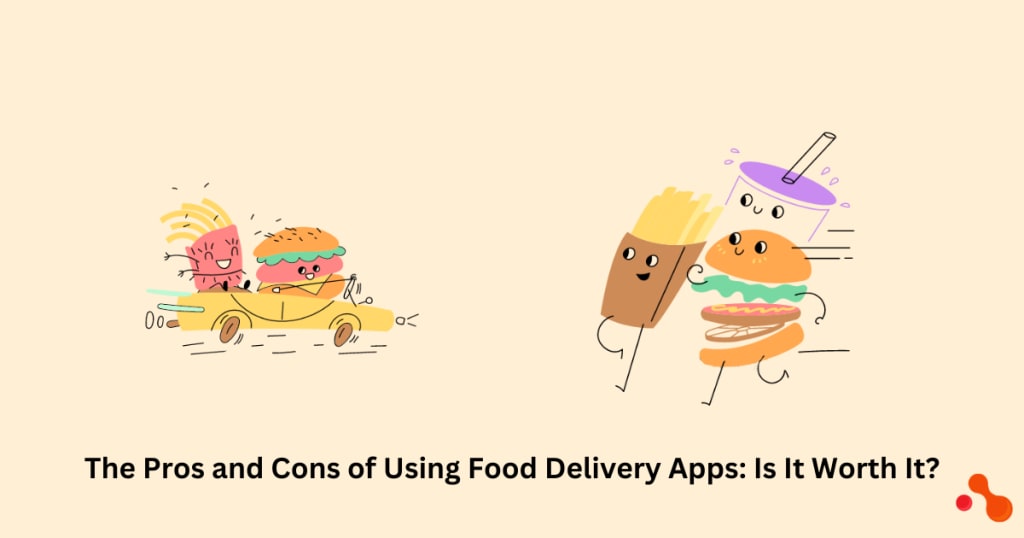The Pros and Cons of Using Food Delivery Apps: Is It Worth It?
Food delivery apps have become increasingly popular, offering convenience and a wide range of dining options at our fingertips.

Introduction
Food delivery apps have become increasingly popular, offering convenience and a wide range of dining options at our fingertips. In this blog, we will explore the pros and cons of using food delivery apps and help you decide whether it's worth incorporating them into your daily routine.
From saving time and effort to enjoying a variety of cuisines, food delivery apps have undeniable benefits. However, there are drawbacks, such as potential quality issues and additional costs. Let's dive into the details and weigh the pros and cons of these apps to make an informed choice.
Pros of Using Food Delivery Apps
Food delivery apps have become increasingly popular, revolutionizing how we order food. These apps provide numerous benefits and conveniences that make them a go-to choice for many people. In this section, we will explore the advantages of using food delivery apps.
Convenience and Time-saving:
- Ordering food through a delivery app is incredibly convenient. You can browse through menus, select your desired items, and place an order with just a few taps on your mobile device.
- Food delivery apps eliminate the need to physically visit restaurants or wait in long queues for takeout, saving you valuable time and effort.
- Apps also offer features like saved addresses and payment details, making the ordering process even faster and more efficient.
Wide Variety of Food Options:
- Food delivery apps provide access to a wide range of cuisines and restaurants, giving you an extensive selection.
- Whether you're craving pizza, sushi, Indian curry, or vegan dishes, you can find a diverse array of options available on these apps.
- These apps often partner with local eateries and popular food chains, ensuring you can explore different flavors and satisfy your cravings.
User-friendly Interfaces:
- Food delivery apps are designed with user-friendliness in mind, making them accessible to people of all ages and technological backgrounds.
- They have intuitive interfaces that allow you to navigate menus, customize orders, and track deliveries effortlessly.
- Features like search filters, ratings, and reviews help you make informed choices about the restaurants and dishes you want to try.
Personalized Recommendations and Deals:
- Food delivery apps utilize algorithms to analyze your preferences and past orders, providing personalized recommendations for restaurants and dishes you might enjoy.
- These apps also offer exclusive deals, discounts, and loyalty programs to incentivize users to order through their platforms.
- By tailoring their offerings to your taste and providing cost-saving opportunities, food delivery apps enhance your overall dining experience.
Example: Suppose you're a busy professional with limited time for cooking or dining out. Using a food delivery app, you can:
- Save time by ordering food from your favorite local restaurant or exploring new options without leaving your home or office.
- Enjoy various culinary choices, such as Italian, Chinese, or Mexican, by accessing multiple restaurant menus in one app.
- Easily customize your order, specifying dietary preferences or requesting extra toppings, all with a few taps on your phone.
- Receive personalized recommendations based on your previous orders, making it easier to discover new dishes or restaurants that align with your taste.
- Benefit from special discounts and promotions, allowing you to enjoy your favorite meals at a lower cost.
Food delivery apps provide a convenient, diverse, and personalized food ordering experience. With their user-friendly interfaces and time-saving features, these apps have transformed how we enjoy meals, making dining more accessible and enjoyable for everyone.
Cons of Using Food Delivery Apps
Food delivery apps have gained immense popularity, revolutionizing how we order food. However, while these apps offer convenience and accessibility, there are certain drawbacks that users should be aware of. This section will discuss some of the disadvantages of using food delivery apps development.
Delivery Delays and Incorrect Orders:
- One of the common issues with food delivery apps is the possibility of experiencing delays in delivery. Factors like traffic, weather conditions, or high demand can cause delays.
- Another concern is the potential for incorrect orders. Miscommunication or human error can result in receiving the wrong items or missing specific instructions.
Example: You order a cheeseburger with no onions, but it arrives with onions, causing inconvenience and dissatisfaction.
Additional Fees and Surcharges:
- Food delivery apps often apply additional fees, such as delivery charges, service fees, or surge pricing during peak hours. These costs can significantly increase the total bill.
- Some apps may also have minimum order requirements or enforce a mandatory tip policy, further impacting the overall cost.
Example: You order a pizza for $10, but after adding the delivery charge and service fee, the final bill comes to $15.
Lack of Control over Food Quality and Freshness:
- When ordering through an app, you relinquish control over the quality and freshness of the food. You have no direct visibility into how the food is prepared or handled.
- The food may arrive cold or lose its optimal taste and texture, depending on the delivery distance.
Example: The sushi you ordered arrives soggy and lukewarm, affecting the overall dining experience.
Environmental Impact:
- Food delivery apps contribute to environmental concerns due to packaging waste and carbon emissions. The excessive use of disposable containers, plastic cutlery, and packaging materials leads to increased waste generation.
- Frequent deliveries by multiple drivers add to carbon emissions and air pollution.
Example: Each food delivery generates plastic containers, utensils, and bags in landfills, contributing to environmental degradation.
While food delivery apps offer convenience, they have their fair share of drawbacks. Users should be mindful of potential delivery delays, incorrect orders, additional fees, lack of control over food quality, and the environmental impact of excessive packaging waste and carbon emissions. By understanding these cons, users can make informed decisions about when and how often to use food delivery apps and consider alternative options when necessary.
Considerations for Using Food Delivery Apps
Food delivery apps have become increasingly popular, offering convenience and a wide range of culinary options at our fingertips. However, before diving headfirst into food delivery apps, it's essential to consider a few factors and make informed decisions. Let's explore some key considerations:
Frequency of Use:
- Assess how frequently you plan to use food delivery apps. Is it an occasional, weekly, or daily habit? Consider the impact on your overall budget and lifestyle.
Budget Constraints:
- Evaluate your financial situation and set a realistic budget for food delivery. While convenience is tempting, excessive use can strain your finances. Be mindful of balancing expenses between eating out and cooking at home.
Supporting Local Businesses and Restaurants:
- Food delivery apps often partner with local restaurants, making it convenient to explore diverse cuisines. You can support your community's economy and help small businesses thrive by ordering from local establishments.
Mitigating Drawbacks through Reviews:
- Before placing an order, take some time to read reviews and ratings for both the restaurant and the delivery service. Look for feedback on food quality, delivery time, and customer service. This can help you make informed choices and avoid disappointments.
Reliable Services:
- Choose food delivery apps known for their reliability and promptness. Check if they have a good track record of delivering orders accurately and on time. This ensures a smoother experience and minimizes the chances of any inconveniences.
Importance of Self-Control:
- It's easy to get carried away with the convenience of food delivery apps and rely on them excessively. However, it's essential to exercise self-control and maintain a balanced approach. Regularly cooking at home can be healthier and more cost-effective in the long run.
Remember, food delivery apps can be convenient, but it's crucial to use them judiciously. By considering factors like frequency of use, budget constraints, supporting local businesses, relying on reviews, and exercising self-control, you can make the most of these apps while maintaining a balanced lifestyle.
Conclusion
In conclusion, food delivery apps have their own set of pros and cons. On the positive side, they provide users with convenience, variety, and time-saving options. However, there are drawbacks, such as higher costs, reliance on technology, and concerns about food quality and freshness. Whether using food delivery apps is worth it depends on individual preferences and needs. Choosing a reliable food delivery app development company that offers excellent services is essential to make the most of these apps.
About the Creator
Mukesh Ram
I founded Acquaint Softtech Private Limited with a vision to make quality developers affordable to everyone. With my blood, sweat, and tears I haven’t just been able to sustain but thrive over the years.






Comments
Mukesh Ram is not accepting comments at the moment
Want to show your support? Send them a one-off tip.